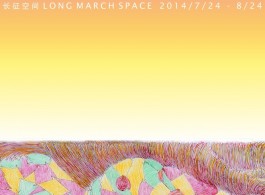Guo Fengyi drew from the wealth of Chinese culture for inspiration. She centered her practice on herself, while externally touching upon nature and internally meridians and beliefs. Guo Fengyi’s art is all-embracing, the themes including human body, nervous system, I Ching, history, biography, cosmology, geography, among others, representing her unique world view in both temporal and spatial aspects.
“LANDSCAPEPORTRAIT” is a selection of fifteen carefully picked-out ink drawings on rice paper from the artist’s oeuvre during the years 1990 to 2006. The subject matters include historic, cultural and divine characters, e.g. Xuanyuan (1990), Bodhisattva No.1 (1998), Statue of Liberty (2003) and Confucius (2007), as well as landscapes like Lugu Lake – If Women Ruled the World (2002). GuoFengyi’s first collaboration with Long March was her participation in the 2002 “Long March Project—A Walking Visual Display” at Lugu Lake. One year later, she began working on the colored ink drawing on Long March, and it was not until seven years later that she accomplished the 22-meter-long Long March Painted by Guo Fengyi (2003-2010), arguably the most ambitious piece of work in her life. It is the first time that this piece is unveiled to the public. The grand dimension presents a set of interesting challenges on the subject of display and meanwhile sparks a string of debates on how to physically look at or view Guo Fengyi’s artworks.
Albeit the wide-ranging themes, Guo Fengyi “anthropomorphosized” the majority of those subject matters when she had them implemented on paper, especially those using rice paper or scroll, which in result generated a visual similarity notwithstanding the thematic difference. For instance, there is usually a singular, enclosed shape in a piece, within which images of face or head are highly recognizable. The facial features together with signatures and inscriptions hint at vertical viewing, which follows the tradition of the display of portraits; therefore, most of Guo Fengyi’s works could be interpreted as portraits from a sheer visual perspective. However, her art-making process accorded with traditions of Chinese landscape painting, which is in particular reflected in her rice paper works. Rice paper is a major medium in her practice, and its attribute of limitless extension allows a relatively freer painting style and enables the piece to physically stretch according to the duration and process of painting. Judging from the sizes and proportions, her works are always long and slender as Chinese landscape paintings. These two co-existing approaches her work, by way of visual attributes or working method, have inevitably led to the ways in which her work could be seen. When one thinks of her work from the viewpoint of visual perception, the pieces ought to be approached by virtue of viewing a portrait, which is displayed vertically; in respect of methodology and her work process, they should be approached by virtue of landscape painting, which traditionally are displayed horizontally.
“LANDSCAPEPORTRAIT” combines the two perspectives of viewing the work of Guo Fengyi. In the rooms filled with portraits primarily, some of which are hung vertically while others are displayed horizontally or simply laid flat, we hope the juxtaposition could bring the audience a fresh outlook into the singular practice of Guo Fengyi.



